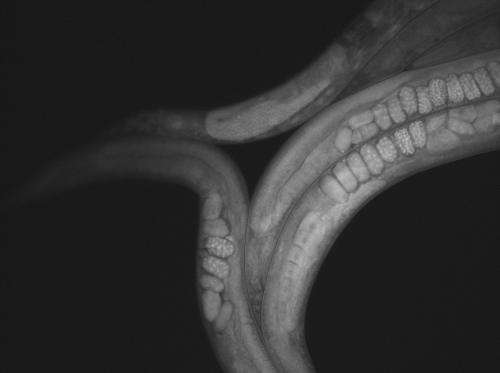Worms in space: Exploring health effects of microgravity

Humans may inevitably explore other planets, moons, and asteroids within our solar system. And although life on Earth has adapted to our planet's gravitational field, this looming possibility begs the question: How will animals and humans adapt to different gravitational environments?
To prepare for people for safely journeying into space for extended periods of time in the future, it's crucial to gain a better understanding of the biophysics involved within reduced gravity and microgravity environments. To this end, a team of University of Delaware researchers is preparing to send transparent microscopic worms called "Caenorhabditas elegans" up to the International Space Station (ISS), probably in a couple years according to the team.
Although for all appearances humans and worms don't have much in common, about 70 percent of the tiny worms' genes are present within our own DNA. During the Biophysical Society's 59th Annual Meeting in Baltimore, Md., Feb. 7-11, 2015, the team will explain how studying worms in space is a convenient way to search for answers to key questions about gravity's impact on epigenetics and other long-term health consequences.
Microgravity isn't considered to be particularly life threatening to many organisms—plants, animals and microbes can all survive aboard the ISS. "But there are notable changes to their biology, presumably because these organisms are adapting to a new environment," said Chandran Sabanayagam, who is an associate scientist at the university's Delaware Biotechnology Institute and an expert in atomic force and single molecule microscopy. "One possible mechanism for adaptation is changes in their epigenome."
What exactly is an epigenome? "It's a combination of DNA (the genome) and associated histone proteins, a sort of biological scaffold that keeps the genome tightly wound and compact," he explained. "The histone proteins have tails that can be marked chemically to act like a switch that instructs the cell to turn on or off nearby genes. Unlike the underlying DNA sequence, histone marks can be changed within a single generation. In general, it takes many generations to change the genome sequence."
To prepare for worm experiments aboard the ISS, the researchers are using "clinorotation, " which is a ground-based microgravity simulator technique that rotates a liquid-filled chamber in such a way that the worms experience free fall.
After exposing the worms to simulated microgravity, they analyze epigenome marks to search for and identify genes that respond to changes in gravity.
What did Sabanayagam and colleagues find? While worms are typically either grown in petri dishes or within a liquid, they tend to be perfectly content in either environment. Yet, interestingly, for worms within liquid, the buoyant force opposes gravity so that they're 10 times lighter—similar to gravity on Pluto. "We see a clear difference in the epigenomes of worms grown in these two different environments, which may be partly due to the reduced gravity experienced by the worms," he noted.
To make sense of their results, the team turned to a suite of bioinformatics tools, which revealed, as expected, "that a number of genes regulated are involved in muscle development and reproduction."
One of the most surprising discoveries is what happens to epigenomes of the worms' offspring. If you take worms grown in liquid and grow their offspring in a petri dish, the offspring have some "epigenetic memory" of their parents' liquid environment.
For how many generations will the epigenetic memory remain? "We're still exploring this aspect of epigenetic elasticity over multiple generations," said Sabanayagam.
While the end goal is to take their experiments with the worms aboard the ISS, in the meantime, the team's clinorotation experiment allows them to conduct many simulated microgravity experiments at considerably reduced time, effort and cost compared to experiments in space. "We're pre-screening the worms in simulated microgravity to select about a hundred or so genes to closely monitor on the ISS," he said.
Biological evolution and adaptation are strongly associated with epigenetics, so although the team's research is focused on the context of microgravity, "our tools and methods can also be used to answer questions related to other environmental changes, such as how diet impacts human epigenetics," Sabanayagam added.
NASA's Astrobiology Science and Technology Instrument Development Program and Space Biology Program supported this research through grants NNX12AR59G and NNX13AM08G.
More information: Poster #B472, " Worms In Space: Epigenetic Response of C. elegans in Simulated Microgravity" by Chandran R. Sabanayagam is being presented at 1:45 p.m. on Tuesday February 10, 2015 in Hall C of the Baltimore convention center. ABSTRACT LINK
Provided by Biophysical Society


















